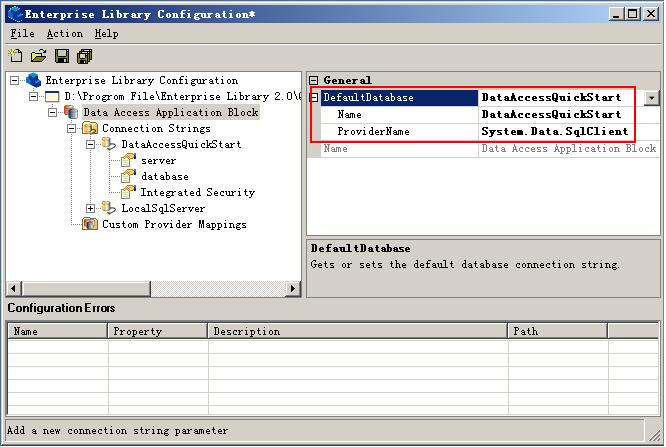Enterprise Library2.0(1):Data Access Application Block
来源:互联网 发布:淘宝几单才有2颗心 编辑:程序博客网 时间:2024/04/24 06:51
Data Access Application Block提供了通用的数据访问的功能,随着2.0版本的推出有了很大变化。
一.改进
在DAAB1.1里面我们知道Database方法返回或者创建一个DBCommandWrapper对象,而在DAAB2.0里面移除了DBCommandWrapper类,用ADO.NET2.0里面的DBCommand类代替实现类似的功能,这样使得DAAB跟我们的.NET类库的结合更加紧密,回忆一下我们在1.1里面用DBCommandWrapper来访问数据时的代码:
而用了新的DBCommand类之后则变成了:<connectionStrings>配置区,这样带来的一个好处是连接字符串可以在Application Block和自定义的.NET类之间共享使用该配置区,如:在.NET2.0下,泛型编程已经成为了一个核心,而2.0版的DAAB中也新增了一个GenericDatabase对象。DAAB中虽然已经包含了SqlDatabase和OrcaleDatabase,但是如果我们需要使用其他的像DB2等数据库时,就需要用到GenericDatabase,它可以用于任何.NET类库中的数据提供者,包括OdbcProvider和OleDbProvider。
而用了新的DBCommand类之后则变成了:<connectionStrings>配置区,这样带来的一个好处是连接字符串可以在Application Block和自定义的.NET类之间共享使用该配置区,如:在.NET2.0下,泛型编程已经成为了一个核心,而2.0版的DAAB中也新增了一个GenericDatabase对象。DAAB中虽然已经包含了SqlDatabase和OrcaleDatabase,但是如果我们需要使用其他的像DB2等数据库时,就需要用到GenericDatabase,它可以用于任何.NET类库中的数据提供者,包括OdbcProvider和OleDbProvider。
 Database db = DatabaseFactory.CreateDatabase();
Database db = DatabaseFactory.CreateDatabase();
 DBCommandWrapper dbCommand = db.GetStoredProcCommandWrapper("GetProductsByCategory");
DBCommandWrapper dbCommand = db.GetStoredProcCommandWrapper("GetProductsByCategory");
 dbCommand.AddInParameter("CategoryID", DbType.Int32, Category);
dbCommand.AddInParameter("CategoryID", DbType.Int32, Category);
 DataSet productDataSet = db.ExecuteDataSet(dbCommand);
DataSet productDataSet = db.ExecuteDataSet(dbCommand); Database db = DatabaseFactory.CreateDatabase();
Database db = DatabaseFactory.CreateDatabase();
 DbCommand dbCommand = db.GetStoredProcCommand("GetProductsByCategory");
DbCommand dbCommand = db.GetStoredProcCommand("GetProductsByCategory"); 
 db.AddInParameter(dbCommand, "CategoryID", DbType.Int32, Category);
db.AddInParameter(dbCommand, "CategoryID", DbType.Int32, Category);
 DataSet productDataSet = db.ExecuteDataSet(dbCommand);
DataSet productDataSet = db.ExecuteDataSet(dbCommand);数据库连接字符串在我们基于数据库的开发永远是少不了的,但是在DAAB1.1下,它所使用的字符串跟我们在.NET类库中使用的连接字符串却是不能共享的,它们分别保存在不同的位置。而在2.0的Data Access Application Block使用了ADO.NET2.0里面
 <connectionStrings>
<connectionStrings> <add
<add name="DataAccessQuickStart"
name="DataAccessQuickStart"  providerName="System.Data.SqlClient"
providerName="System.Data.SqlClient" connectionString="server=(local)/SQLEXPRESS;database=EntLibQuickStarts;Integrated Security=true" />
connectionString="server=(local)/SQLEXPRESS;database=EntLibQuickStarts;Integrated Security=true" /> </connectionStrings>
</connectionStrings>二.使用示例
DAAB2.0的配置非常简单,主要有以下几方面的配置:
配置连接字符串

配置默认数据库

添加相关的命名空间:
使用Data Access Application Block进行数据的读取和操作,一般分为三步:
使用Data Access Application Block进行数据的读取和操作,一般分为三步:
 using Microsoft.Practices.EnterpriseLibrary.Data;
using Microsoft.Practices.EnterpriseLibrary.Data; using System.Data;
using System.Data;1.创建Database对象
2.提供命令参数,如果需要的话
3.执行命令
下面分别看一下DataAccessQuickStart中提供的一些例子:
执行静态的SQL语句
执行存储过程并传递参数,返回DataSet利用DataSet更新数据通过ID获取记录详细信息以XML格式返回数据使用事务三.常见功能
执行存储过程并传递参数,返回DataSet利用DataSet更新数据通过ID获取记录详细信息以XML格式返回数据使用事务三.常见功能
 public string GetCustomerList()
public string GetCustomerList()

 {
{ // 创建Database对象
// 创建Database对象 Database db = DatabaseFactory.CreateDatabase();
Database db = DatabaseFactory.CreateDatabase(); // 使用SQL语句创建DbCommand对象
// 使用SQL语句创建DbCommand对象 string sqlCommand = "Select CustomerID, Name, Address, City, Country, PostalCode " +
string sqlCommand = "Select CustomerID, Name, Address, City, Country, PostalCode " + "From Customers";
"From Customers"; DbCommand dbCommand = db.GetSqlStringCommand(sqlCommand);
DbCommand dbCommand = db.GetSqlStringCommand(sqlCommand);
 StringBuilder readerData = new StringBuilder();
StringBuilder readerData = new StringBuilder();
 // 调用ExecuteReader方法
// 调用ExecuteReader方法 using (IDataReader dataReader = db.ExecuteReader(dbCommand))
using (IDataReader dataReader = db.ExecuteReader(dbCommand))

 {
{ while (dataReader.Read())
while (dataReader.Read())

 {
{ // Get the value of the 'Name' column in the DataReader
// Get the value of the 'Name' column in the DataReader readerData.Append(dataReader["Name"]);
readerData.Append(dataReader["Name"]); readerData.Append(Environment.NewLine);
readerData.Append(Environment.NewLine); }
} }
}
 return readerData.ToString();
return readerData.ToString(); }
} public DataSet GetProductsInCategory(int Category)
public DataSet GetProductsInCategory(int Category)

 {
{ // Create the Database object, using the default database service. The
// Create the Database object, using the default database service. The // default database service is determined through configuration.
// default database service is determined through configuration. Database db = DatabaseFactory.CreateDatabase();
Database db = DatabaseFactory.CreateDatabase();
 string sqlCommand = "GetProductsByCategory";
string sqlCommand = "GetProductsByCategory"; DbCommand dbCommand = db.GetStoredProcCommand(sqlCommand);
DbCommand dbCommand = db.GetStoredProcCommand(sqlCommand);
 // Retrieve products from the specified category.
// Retrieve products from the specified category. db.AddInParameter(dbCommand, "CategoryID", DbType.Int32, Category);
db.AddInParameter(dbCommand, "CategoryID", DbType.Int32, Category);
 // DataSet that will hold the returned results
// DataSet that will hold the returned results  DataSet productsDataSet = null;
DataSet productsDataSet = null;
 productsDataSet = db.ExecuteDataSet(dbCommand);
productsDataSet = db.ExecuteDataSet(dbCommand);
 // Note: connection was closed by ExecuteDataSet method call
// Note: connection was closed by ExecuteDataSet method call 
 return productsDataSet;
return productsDataSet; }
} public int UpdateProducts()
public int UpdateProducts()

 {
{ // Create the Database object, using the default database service. The
// Create the Database object, using the default database service. The // default database service is determined through configuration.
// default database service is determined through configuration. Database db = DatabaseFactory.CreateDatabase();
Database db = DatabaseFactory.CreateDatabase();
 DataSet productsDataSet = new DataSet();
DataSet productsDataSet = new DataSet();
 string sqlCommand = "Select ProductID, ProductName, CategoryID, UnitPrice, LastUpdate " +
string sqlCommand = "Select ProductID, ProductName, CategoryID, UnitPrice, LastUpdate " + "From Products";
"From Products"; DbCommand dbCommand = db.GetSqlStringCommand(sqlCommand);
DbCommand dbCommand = db.GetSqlStringCommand(sqlCommand);
 string productsTable = "Products";
string productsTable = "Products";
 // Retrieve the initial data
// Retrieve the initial data db.LoadDataSet(dbCommand, productsDataSet, productsTable);
db.LoadDataSet(dbCommand, productsDataSet, productsTable);
 // Get the table that will be modified
// Get the table that will be modified DataTable table = productsDataSet.Tables[productsTable];
DataTable table = productsDataSet.Tables[productsTable];
 // Add a new product to existing DataSet
// Add a new product to existing DataSet
 DataRow addedRow = table.Rows.Add(new object[]
DataRow addedRow = table.Rows.Add(new object[]  {DBNull.Value, "New product", 11, 25});
{DBNull.Value, "New product", 11, 25});
 // Modify an existing product
// Modify an existing product table.Rows[0]["ProductName"] = "Modified product";
table.Rows[0]["ProductName"] = "Modified product";
 // Establish our Insert, Delete, and Update commands
// Establish our Insert, Delete, and Update commands DbCommand insertCommand = db.GetStoredProcCommand("AddProduct");
DbCommand insertCommand = db.GetStoredProcCommand("AddProduct"); db.AddInParameter(insertCommand, "ProductName", DbType.String, "ProductName", DataRowVersion.Current);
db.AddInParameter(insertCommand, "ProductName", DbType.String, "ProductName", DataRowVersion.Current); db.AddInParameter(insertCommand, "CategoryID", DbType.Int32, "CategoryID", DataRowVersion.Current);
db.AddInParameter(insertCommand, "CategoryID", DbType.Int32, "CategoryID", DataRowVersion.Current); db.AddInParameter(insertCommand, "UnitPrice", DbType.Currency, "UnitPrice", DataRowVersion.Current);
db.AddInParameter(insertCommand, "UnitPrice", DbType.Currency, "UnitPrice", DataRowVersion.Current);
 DbCommand deleteCommand = db.GetStoredProcCommand("DeleteProduct");
DbCommand deleteCommand = db.GetStoredProcCommand("DeleteProduct"); db.AddInParameter(deleteCommand, "ProductID", DbType.Int32, "ProductID", DataRowVersion.Current);
db.AddInParameter(deleteCommand, "ProductID", DbType.Int32, "ProductID", DataRowVersion.Current);
 DbCommand updateCommand = db.GetStoredProcCommand("UpdateProduct");
DbCommand updateCommand = db.GetStoredProcCommand("UpdateProduct"); db.AddInParameter(updateCommand, "ProductID", DbType.Int32, "ProductID", DataRowVersion.Current);
db.AddInParameter(updateCommand, "ProductID", DbType.Int32, "ProductID", DataRowVersion.Current); db.AddInParameter(updateCommand, "ProductName", DbType.String, "ProductName", DataRowVersion.Current);
db.AddInParameter(updateCommand, "ProductName", DbType.String, "ProductName", DataRowVersion.Current); db.AddInParameter(updateCommand, "LastUpdate", DbType.DateTime, "LastUpdate", DataRowVersion.Current);
db.AddInParameter(updateCommand, "LastUpdate", DbType.DateTime, "LastUpdate", DataRowVersion.Current);
 // Submit the DataSet, capturing the number of rows that were affected
// Submit the DataSet, capturing the number of rows that were affected int rowsAffected = db.UpdateDataSet(productsDataSet, "Products", insertCommand, updateCommand,
int rowsAffected = db.UpdateDataSet(productsDataSet, "Products", insertCommand, updateCommand, deleteCommand, UpdateBehavior.Standard);
deleteCommand, UpdateBehavior.Standard);
 return rowsAffected;
return rowsAffected;
 }
} public string GetProductDetails(int productID)
public string GetProductDetails(int productID)

 {
{ // Create the Database object, using the default database service. The
// Create the Database object, using the default database service. The // default database service is determined through configuration.
// default database service is determined through configuration. Database db = DatabaseFactory.CreateDatabase();
Database db = DatabaseFactory.CreateDatabase();
 string sqlCommand = "GetProductDetails";
string sqlCommand = "GetProductDetails"; DbCommand dbCommand = db.GetStoredProcCommand(sqlCommand);
DbCommand dbCommand = db.GetStoredProcCommand(sqlCommand);
 // Add paramters
// Add paramters // Input parameters can specify the input value
// Input parameters can specify the input value db.AddInParameter(dbCommand, "ProductID", DbType.Int32, productID);
db.AddInParameter(dbCommand, "ProductID", DbType.Int32, productID); // Output parameters specify the size of the return data
// Output parameters specify the size of the return data db.AddOutParameter(dbCommand, "ProductName", DbType.String, 50);
db.AddOutParameter(dbCommand, "ProductName", DbType.String, 50); db.AddOutParameter(dbCommand, "UnitPrice", DbType.Currency, 8);
db.AddOutParameter(dbCommand, "UnitPrice", DbType.Currency, 8);
 db.ExecuteNonQuery(dbCommand);
db.ExecuteNonQuery(dbCommand);
 // Row of data is captured via output parameters
// Row of data is captured via output parameters string results = string.Format(CultureInfo.CurrentCulture, "{0}, {1}, {2:C} ",
string results = string.Format(CultureInfo.CurrentCulture, "{0}, {1}, {2:C} ", db.GetParameterValue(dbCommand, "ProductID"),
db.GetParameterValue(dbCommand, "ProductID"), db.GetParameterValue(dbCommand, "ProductName"),
db.GetParameterValue(dbCommand, "ProductName"), db.GetParameterValue(dbCommand, "UnitPrice"));
db.GetParameterValue(dbCommand, "UnitPrice"));
 return results;
return results; }
} public string GetProductList()
public string GetProductList()

 {
{ // Use a named database instance that refers to a SQL Server database.
// Use a named database instance that refers to a SQL Server database. SqlDatabase dbSQL = DatabaseFactory.CreateDatabase() as SqlDatabase;
SqlDatabase dbSQL = DatabaseFactory.CreateDatabase() as SqlDatabase;
 // Use "FOR XML AUTO" to have SQL return XML data
// Use "FOR XML AUTO" to have SQL return XML data string sqlCommand = "Select ProductID, ProductName, CategoryID, UnitPrice, LastUpdate " +
string sqlCommand = "Select ProductID, ProductName, CategoryID, UnitPrice, LastUpdate " + "From Products FOR XML AUTO";
"From Products FOR XML AUTO"; DbCommand dbCommand = dbSQL.GetSqlStringCommand(sqlCommand);
DbCommand dbCommand = dbSQL.GetSqlStringCommand(sqlCommand);
 XmlReader productsReader = null;
XmlReader productsReader = null; StringBuilder productList = new StringBuilder();
StringBuilder productList = new StringBuilder();
 try
try

 {
{ productsReader = dbSQL.ExecuteXmlReader(dbCommand);
productsReader = dbSQL.ExecuteXmlReader(dbCommand);
 // Iterate through the XmlReader and put the data into our results.
// Iterate through the XmlReader and put the data into our results. while (!productsReader.EOF)
while (!productsReader.EOF)

 {
{ if (productsReader.IsStartElement())
if (productsReader.IsStartElement())

 {
{ productList.Append(productsReader.ReadOuterXml());
productList.Append(productsReader.ReadOuterXml()); productList.Append(Environment.NewLine);
productList.Append(Environment.NewLine); }
} }
} }
} finally
finally

 {
{ // Close the Reader.
// Close the Reader. if (productsReader != null)
if (productsReader != null)

 {
{ productsReader.Close();
productsReader.Close(); }
}
 // Explicitly close the connection. The connection is not closed
// Explicitly close the connection. The connection is not closed // when the XmlReader is closed.
// when the XmlReader is closed. if (dbCommand.Connection != null)
if (dbCommand.Connection != null)

 {
{ dbCommand.Connection.Close();
dbCommand.Connection.Close(); }
}  }
}
 return productList.ToString();
return productList.ToString(); }
} public bool Transfer(int transactionAmount, int sourceAccount, int destinationAccount)
public bool Transfer(int transactionAmount, int sourceAccount, int destinationAccount)

 {
{ bool result = false;
bool result = false;
 // Create the Database object, using the default database service. The
// Create the Database object, using the default database service. The // default database service is determined through configuration.
// default database service is determined through configuration. Database db = DatabaseFactory.CreateDatabase();
Database db = DatabaseFactory.CreateDatabase();
 // Two operations, one to credit an account, and one to debit another
// Two operations, one to credit an account, and one to debit another // account.
// account. string sqlCommand = "CreditAccount";
string sqlCommand = "CreditAccount"; DbCommand creditCommand = db.GetStoredProcCommand(sqlCommand);
DbCommand creditCommand = db.GetStoredProcCommand(sqlCommand);
 db.AddInParameter(creditCommand, "AccountID", DbType.Int32, sourceAccount);
db.AddInParameter(creditCommand, "AccountID", DbType.Int32, sourceAccount); db.AddInParameter(creditCommand, "Amount", DbType.Int32, transactionAmount);
db.AddInParameter(creditCommand, "Amount", DbType.Int32, transactionAmount);
 sqlCommand = "DebitAccount";
sqlCommand = "DebitAccount"; DbCommand debitCommand = db.GetStoredProcCommand(sqlCommand);
DbCommand debitCommand = db.GetStoredProcCommand(sqlCommand);
 db.AddInParameter(debitCommand, "AccountID", DbType.Int32, destinationAccount);
db.AddInParameter(debitCommand, "AccountID", DbType.Int32, destinationAccount); db.AddInParameter(debitCommand, "Amount", DbType.Int32, transactionAmount);
db.AddInParameter(debitCommand, "Amount", DbType.Int32, transactionAmount);
 using (DbConnection connection = db.CreateConnection())
using (DbConnection connection = db.CreateConnection())

 {
{ connection.Open();
connection.Open(); DbTransaction transaction = connection.BeginTransaction();
DbTransaction transaction = connection.BeginTransaction();
 try
try

 {
{ // Credit the first account
// Credit the first account db.ExecuteNonQuery(creditCommand, transaction);
db.ExecuteNonQuery(creditCommand, transaction); // Debit the second account
// Debit the second account db.ExecuteNonQuery(debitCommand, transaction);
db.ExecuteNonQuery(debitCommand, transaction);
 // Commit the transaction
// Commit the transaction transaction.Commit();
transaction.Commit();
 result = true;
result = true; }
} catch
catch

 {
{ // Rollback transaction
// Rollback transaction  transaction.Rollback();
transaction.Rollback(); }
} connection.Close();
connection.Close();
 return result;
return result; }
} }
}1.创建Database对象
创建一个默认的Database对象
创建一个实例Database对象
创建一个具体的类型的数据库对象2.创建DbCommand对象
创建一个实例Database对象
创建一个具体的类型的数据库对象2.创建DbCommand对象
 Database dbSvc = DatabaseFactory.CreateDatabase();
Database dbSvc = DatabaseFactory.CreateDatabase();默认的数据库在配置文件中:
 <dataConfiguration defaultDatabase="DataAccessQuickStart" />
<dataConfiguration defaultDatabase="DataAccessQuickStart" /> // Use a named database instance that refers to an arbitrary database type,
// Use a named database instance that refers to an arbitrary database type,  // which is determined by configuration information.
// which is determined by configuration information. Database myDb = DatabaseFactory.CreateDatabase("DataAccessQuickStart");
Database myDb = DatabaseFactory.CreateDatabase("DataAccessQuickStart"); // Create a SQL database.
// Create a SQL database. SqlDatabase dbSQL = DatabaseFactory.CreateDatabase("DataAccessQuickStart") as SqlDatabase;
SqlDatabase dbSQL = DatabaseFactory.CreateDatabase("DataAccessQuickStart") as SqlDatabase;静态的SQL语句创建一个DbCommand
存储过程创建一个DbCommand3.管理对象
存储过程创建一个DbCommand3.管理对象
 Database db = DatabaseFactory.CreateDatabase();
Database db = DatabaseFactory.CreateDatabase(); string sqlCommand = "Select CustomerID, LastName, FirstName From Customers";
string sqlCommand = "Select CustomerID, LastName, FirstName From Customers"; DbCommand dbCommand = db.GetSqlStringCommand(sqlCommand);
DbCommand dbCommand = db.GetSqlStringCommand(sqlCommand); Database db = DatabaseFactory.CreateDatabase();
Database db = DatabaseFactory.CreateDatabase(); DbCommand dbCommand = db.GetStoredProcCommand("GetProductsByCategory");
DbCommand dbCommand = db.GetStoredProcCommand("GetProductsByCategory");当连接对象打开后,不需要再次连接
使用Using及早释放对象4.参数处理
使用Using及早释放对象4.参数处理
 Database db = DatabaseFactory.CreateDatabase();
Database db = DatabaseFactory.CreateDatabase(); string sqlCommand = "Select ProductID, ProductName From Products";
string sqlCommand = "Select ProductID, ProductName From Products"; DbCommand dbCommand = db.GetSqlStringCommand(sqlCommand);
DbCommand dbCommand = db.GetSqlStringCommand(sqlCommand);  // No need to open the connection; just make the call.
// No need to open the connection; just make the call. DataSet customerDataSet = db.ExecuteDataSet(dbCommand);
DataSet customerDataSet = db.ExecuteDataSet(dbCommand); Database db = DatabaseFactory.CreateDatabase();
Database db = DatabaseFactory.CreateDatabase(); DbCommand dbCommand = db.GetSqlStringCommand("Select Name, Address From Customers");
DbCommand dbCommand = db.GetSqlStringCommand("Select Name, Address From Customers"); using (IDataReader dataReader = db.ExecuteReader(dbCommand))
using (IDataReader dataReader = db.ExecuteReader(dbCommand))

 {
{ // Process results
// Process results }
}Database类提供了如下的方法,用于参数的处理:
AddParameter. 传递参数给存储过程
AddInParameter. 传递输入参数给存储过程
AddOutParameter. 传递输出参数给存储过程
GetParameterValue. 得到指定参数的值
SetParameterValue. 设定参数值
AddInParameter. 传递输入参数给存储过程
AddOutParameter. 传递输出参数给存储过程
GetParameterValue. 得到指定参数的值
SetParameterValue. 设定参数值
使用示例如下:
四.使用场景
四.使用场景
 Database db = DatabaseFactory.CreateDatabase();
Database db = DatabaseFactory.CreateDatabase(); string sqlCommand = "GetProductDetails";
string sqlCommand = "GetProductDetails"; DbCommand dbCommand = db.GetStoredProcCommand(sqlCommand);
DbCommand dbCommand = db.GetStoredProcCommand(sqlCommand); db.AddInParameter(dbCommand, "ProductID", DbType.Int32, 5);
db.AddInParameter(dbCommand, "ProductID", DbType.Int32, 5); db.AddOutParameter(dbCommand, "ProductName", DbType.String, 50);
db.AddOutParameter(dbCommand, "ProductName", DbType.String, 50); db.AddOutParameter(dbCommand, "UnitPrice", DbType.Currency, 8);
db.AddOutParameter(dbCommand, "UnitPrice", DbType.Currency, 8); Database db = DatabaseFactory.CreateDatabase();
Database db = DatabaseFactory.CreateDatabase(); DbCommand insertCommand = db.GetStoredProcCommand("AddProduct");
DbCommand insertCommand = db.GetStoredProcCommand("AddProduct"); db.AddInParameter(insertCommand, "ProductName", DbType.String, "ProductName", DataRowVersion.Current);
db.AddInParameter(insertCommand, "ProductName", DbType.String, "ProductName", DataRowVersion.Current); db.AddInParameter(insertCommand, "CategoryID", DbType.Int32, "CategoryID", DataRowVersion.Current);
db.AddInParameter(insertCommand, "CategoryID", DbType.Int32, "CategoryID", DataRowVersion.Current); db.AddInParameter(insertCommand, "UnitPrice", DbType.Currency, "UnitPrice", DataRowVersion.Current);
db.AddInParameter(insertCommand, "UnitPrice", DbType.Currency, "UnitPrice", DataRowVersion.Current);DAAB2.0是对ADO.NET2.0的补充,它允许你使用相同的数据访问代码来支持不同的数据库,您通过改变配置文件就在不同的数据库之间切换。目前虽然只提供SQLServer和Oracle的支持,但是可以通过GenericDatabase和ADO.NET 2.0下的DbProviderFactory对象来增加对其他数据库的支持。如果想要编写出来的数据库访问程序具有更好的移植性,则DAAB2.0是一个不错的选择,但是如果您想要针对特定数据库的特性进行编程,就要用ADO.NET了。
参考:Enterprise Libaray –January 2006帮助文档及QuickStart
- Enterprise Library2.0(1):Data Access Application Block
- Enterprise Library2.0(1):Data Access Application Block学习
- Enterprise Library2.0(1):Data Access Application Block学习
- Enterprise Library2.0(1):Data Access Application Block学习
- Enterprise Library2.0(2):Logging Application Block
- Enterprise Library2.0(2):Logging Application Block学习
- Enterprise Library: Data Access Application Block使用向导,Part 1
- Enterprise Library 2.0 -- Data Access Application Block
- Enterprise Library 2.0 -- Data Access Application Block
- Enterprise Library 2.0 -- Data Access Application Block
- Enterprise Library 2.0 -- Data Access Application Block
- Enterprise Library: Data Access Application Block使用向导,Part 2
- Enterprise Library 2.0 -- Data Access Application Block (补充)
- Enterprise Library: Data Access Application Block类设计分析篇
- Enterprise Library: Data Access Application Block类设计分析篇
- TransactionScope和Enterprise Libray 3.0 Data Access Application Block
- Enterprise Library May 2007 Data Access Application Block的使用
- Get Started with the Enterprise Library Data Access Application Block
- 论二战东线作战中德国战胜苏联的可能性
- How to study C && ASM Code(3)
- How to study C && ASM Code(6)
- Qmail控制文件详解
- How to study C && ASM Code(4)
- Enterprise Library2.0(1):Data Access Application Block
- MFC学习点滴三:句柄,指针,对象,资源的ID
- VC6打开临时文件,导致特权执行漏洞
- Enterprise Library2.0(2):Logging Application Block
- 有点想kill掉......
- BIRT的书
- Discuz! 5.5.0(GBK版本) CMS 1.1 文章系统发布(最后更新:2007-4-18)
- 《解剖PetShop》系列之一
- 《解剖PetShop》系列之二


